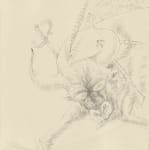

André Masson
Tauromachie (Bullfighting), 1937 'circa'
Signed 'andré masson' (lower right); signed 'andré masson' (upper left)
Pen and ink on paper
63 by 49 cm (24¾ by 19¼ in.)
69416
Sold
Executed circa 1937. André Masson’s Tauromachie was created around the outbreak of the Spanish Civil War, which forced the artist to leave his home in Tossa de Mar, Spain, and...
Executed circa 1937. André Masson’s Tauromachie was created around the outbreak of the Spanish Civil War, which forced the artist to leave his home in Tossa de Mar, Spain, and return to his native France. In the mid-to-late-1930s, the theme of the bullfight possessed Masson, who created a number of works depicting scenes in the ring. While living in Spain, he was inspired by the ritual of the corrida; of the tradition he said, “The visual aspect, the spectacle ... is magnificent; when man and beast seem wedded. There are sublime moments.” The central bull in Tauromachie, bucking and writhing as knives and spears penetrate its skin, is possibly a metaphor for the violent spectacle of the Spanish Civil War, which left Masson reeling as he was forced to flee the country.

